iRayUSA RS75 Thermal: Best New Thermal Scope?
At RECOIL, we review every product fairly and without bias. Making a purchase through one of our links may earn us a small commission, and helps support independent gun reviews. Read our affiliate policy.
Find out more about how we test products.
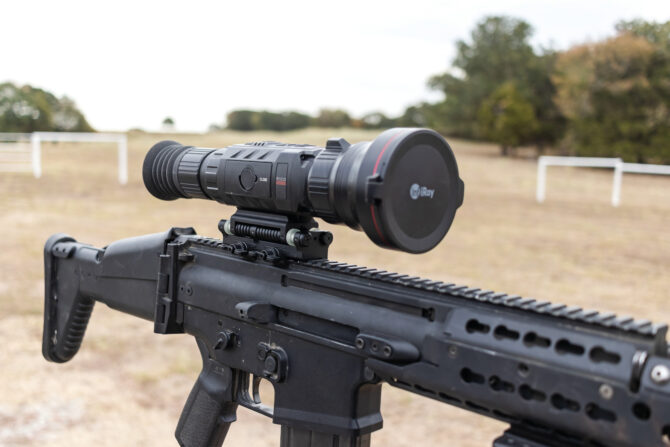
You probably aren’t going to buy this, but it’s still going to change your world.
When 4K televisions dropped onto the scene in 2012, they had $20,000 price tags but shocked with eye-popping performance no one had ever seen before. For most folks, they were mostly proof-of-concept pieces to gawk at and wonder what tax bracket could actually own one.
Fast-forwarding to today, now that technology is both commonplace and affordable. Like that 4K TV probably adorning your living room right now compared to the previous standard, the new iRayUSA RICO HD RS75 provides four times the resolution of any rifle-mounted thermal on the market.
And at $17,999, it’s beyond many peoples’ wallet.
With the release of iRayUSA’s new optic, the thermal industry just heard the loud clunk of one Thanos-sized gauntlet being thrown down. Teeny, low-resolution sensors providing pixelated pig pictures are no longer cool or cutting edge.
YouTube hunting videos can now go full screen without turning coyotes into Minecraft animals. Video-producing varminters with the spare cash now have a new level of flex — all of which sucks for mortals who are looking for a midrange or entry-level thermal, right? Nope.
Tech advancements come fast, and the RS75’s mere existence will drive down the price of so-called “normal” thermals, as well as kickstart an arms race for everyone to do it better. With “everyone” meaning both competitors as well as iRay themselves.
LENS AND SENSOR
Bottom line up front: Every article you’re ever going to see about this optic is going to yammer on a lot about the sensor. The uncooled micro-bolometer sensor (the “eye” of the camera) that detects heat is 1280×1024. The big news is that’s four times bigger than formerly state-of-art 640 resolution scopes (there are twice as many of those little 12um pixels horizontally, as well as twice vertically).
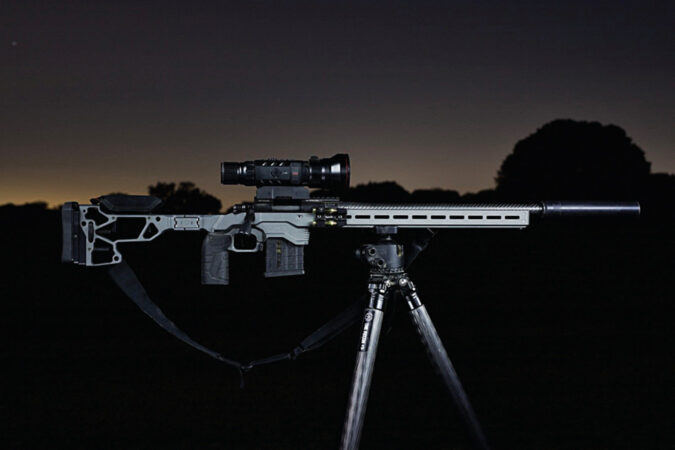
And if you’re running last year’s 340-pixel optic, prepare to FOMO on the fact that there’s a whopping 11.85 times more visual information coming out of the RS75. A difference that’s hard to overstate.
The lens and sensor work together to gather many more photon waves worth of information than smaller systems, detecting target heat from as far as 3,600 yards away. That data is then converted to the familiar Predator-like thermomap, building a picture by assigning different-colored pixels to the varying levels of cold or hot.
Bigger sensor equals bigger box of crayons. The more levels of information make a clearer, more precise, and much larger video. But there’s a lot more to this story than the mere sensor spec.
Beginning up front where the picture quality starts, the RS75 has an unusually huge 75mm f/1.0 germanium lens. Germanium is a rare element that’s transparent to infrared radiation, so — unlike glass — it sees and sucks up that heat radiation instead of visible light waves.
While big lenses might usually be associated with high magnification, it’s used here for a different reason: as the thermal sensor gets larger, the width of the lens must be larger in order to keep the angle wide.
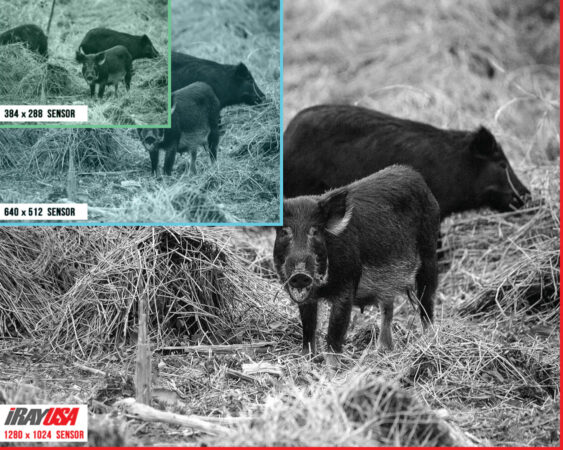
Having a big lens with a smaller sensor is like having an over-zoomed dayscope — you get a super-detailed closeup with a tight FOV. But put a bigger lens on a larger sensor like InfiRay Outdoor and you not only have a wide 2x native field-of-view, but also the available resolution to take advantage of higher levels of digital zoom.
Each time you zoom in on those pixels you’re losing picture quality. But since a 1280×1024 pixel count is so high to begin with (1,310,720 in total!), running up the digital magnification means an RS75 with a 2x digital zoom will have the same resolution as a native 640 sensor, or the resolution of a 384 sensor at 8x zoom. Hog hunters and hunters who need to track runners moving side-to-side will value the RS75’s FOV of 11.7ºx9.4º at the native 2x optical magnification. Higher magnification levels (4x, 8x, 16x, and the 32x maximum) use digital zoom in conjunction with the native 2x optical zoom to provide a usable increase for those who need to reach out farther.
EYEPIECE AND BATTERIES
If we haven’t lost you already with the camera-nerd math, let’s switch to the secret weapon that’s on the backside of this optic: the eyepiece. Simply put, it gives an impressive jump from old tech and a very immersive experience.
A traditional eyepiece in a thermal scope is just a simple, flat little display with a diopter to focus your eye to the screen. Whereas the lens system in the RS75 is an orthoscopic (slightly curved and magnified) lens set that provides increased magnification of the display as well as lower distortion, allowing the 1280 sensor to truly pop from edge to edge.
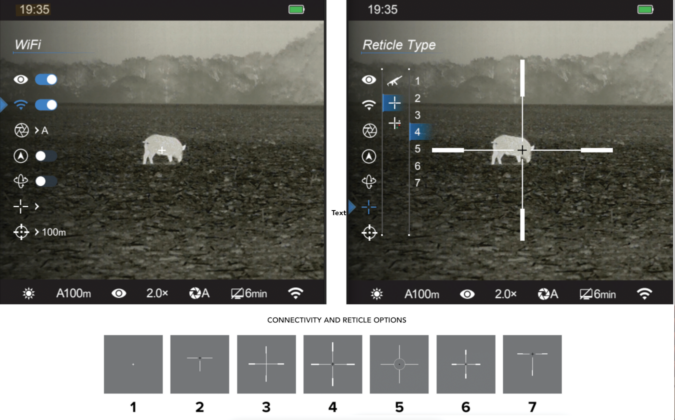
And it’s big. Most manufacturers don’t bother listing any specs other than the pixel count of their screens. They’re usually less than a ½ inch in size and put out 640×480 resolution, whereas iRay offers a huge 1.07-inch AMOLED screen with resolution of 2560×2560, about 6.5 megapixels. This makes for a forgiving eyebox with 60mm of relief.
You can literally stand back from the scope and still see the display without cramming your pupil into it. This is one of the exciting elements of this scope that we’d expect to easily trickle-down to lesser-priced units in the near future.
The refresh rate of the screen is 30 Hz, which isn’t the highest possible, but with so much data you have to blend battery life and processing power. When combined with the wide FOV and the resolution, the slower rate isn’t that noticeable.
Speaking of batteries, the unit comes with two batteries that can be recharged in the field or at home, and it can optionally run off aftermarket external USB-C power sources like you use to charge your phone. It’s certainly achievable to get a full night’s use out of the optic with the two included batteries.
GETTING PHYSICAL
As far as physical size, it’s 12.28 inches long, 3 inches tall, with a 1.7-inch centerline of the eyepiece when it’s mounted to your rifle’s rail. That’s a similar length to a Leupold 3.6-18x44mm scope that we pulled off the Ruger SFAR .308 test rifle to mount the iRay.
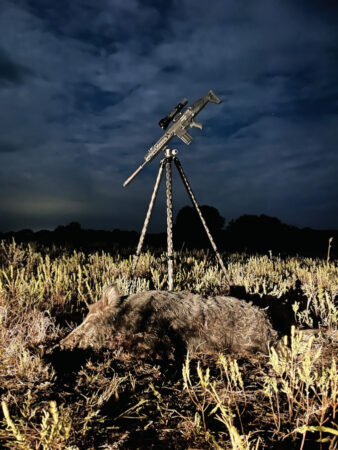
It includes a recoil-mitigating mount, which rates the system for recoil up to .300WM/7mm Mag. The whole setup is a bit chubby at 44 ounces, which isn’t entirely unexpected for all the tech crammed in it. Also, let’s face it: night rigs like this mostly get used on tripods, off truck hoods, and in deer blinds.
BONUS FEATURES
In addition to the bare guts of the unit, the bells and whistles are fun and useful as well. There’s a lot of emphasis on helping you share those high-definition thermal videos with the world. The RS75 records video and has newly improved audio capabilities to document your hunt, from picking up whispers of “going hot!” to capturing bullet impacts way downrange.
You can wirelessly stream photos and video to a smartphone app, broadcast your gunsight videos instantly to social media, or just store your content on 128GB of internal memory for in-scope or tablet review in the field.
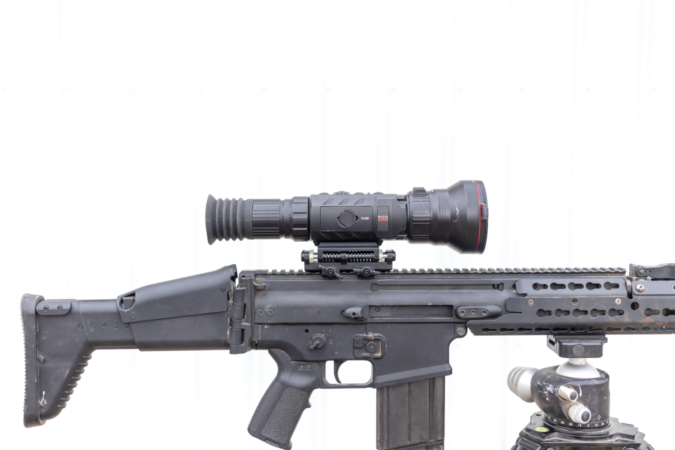
As a high-tech bonus, the RS75 ships with iRay’s ILR-1,000-yard laser rangefinder. It integrates with the unit, overlaying real-time distance data (accurate to +/- 1 yard) directly onto the thermal’s display so you’ll never have to guess how far away the target is or pull out a separate rangefinder.
LOOSE ROUNDS
It’s been about 10 years since this sort of big leap of technology happened in the thermal world, so iRay decided we were due for a new one. If you’re in the tax bracket that can afford this scope now, you’re going to be pleased. If you’re waiting for this tech to trickle down, you’re in luck too — but maybe next Christmas.
Why you can trust RECOIL
Since our founding in 2012, RECOIL remains the premier firearms lifestyle publication for the modern shooting enthusiast. We deliver cutting-edge coverage of guns, gear, accessories and technology. We go beyond basic reviews, providing no B.S. buyer’s guides, hands-on testing and expert analysis on everything from firearms and survival equipment to watches and vehicles.
Our reviewers are the backbone of our operation and come from diverse shooting backgrounds: Former law enforcement, military veterans, competitive shooters, seasoned hunters and plain old firearms enthusiasts. Furthermore, we’re not just gun experts, but dedicated journalists who adhere to the strictest standards of our profession.
At RECOIL, editorial independence is the foundation of everything we publish and the cornerstone of reader trust. Our editors, writers and content creators make all editorial decisions independently, free from outside influence. That boils down to: advertisers don’t dictate our coverage, the outcomes of our reviews or what we recommend in our buyer’s guides. First and always, our commitment is to our audience—ensuring every review and article is accurate, unbiased, and driven by real-world experience.
Whether you’re selecting your next firearm, upgrading your gear, or exploring the latest innovations in the shooting world, RECOIL provides the trusted insights you need to make informed decisions. Learn more about our Editorial Standards and how we review products.
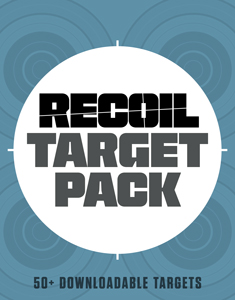
NEXT STEP: Download Your Free Target Pack from RECOIL
For years, RECOIL magazine has treated its readers to a full-size (sometimes full color!) shooting target tucked into each big issue. Now we've compiled over 50 of our most popular targets into this one digital PDF download. From handgun drills to AR-15 practice, these 50+ targets have you covered. Print off as many as you like (ammo not included).Get your pack of 50 Print-at-Home targets when you subscribe to the RECOIL email newsletter. We'll send you weekly updates on guns, gear, industry news, and special offers from leading manufacturers - your guide to the firearms lifestyle.
You want this. Trust Us.

